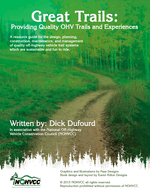National Off-Highway Vehicle Conservation Council (NOHVCC)
Great Trails: Providing Quality OHV Trails and Experiences Guidebook
Trail Competencies
-
Trail Construction
-
Summary
The definitive guide for the planning, designing, constructing, managing and maintaining Off-Highway Vehicle (OHV) trails.
Overview
Great Trails: Providing Quality OHV Trails and Experiences is the definitive resource for planning, designing, constructing, maintaining, and managing Off-Highway Vehicle (OHV) recreational trails and trail systems. The primary audience for the guidebook is state and federal planners, trail managers, and land managers. Others who will find the publication invaluable include trail volunteers, OHV clubs and associations, and private land owners and trail managers.
In 2011 research by the National Off-Highway Vehicle Conservation Council (NOHVCC) concluded that the existing publications regarding OHV trail design, construction, and maintenance were outdated, did not include information about newer vehicle types, and didn’t include information about the latest design, construction, and maintenance techniques. Most of the material was created on the 1970s prior to the introduction of All-Terrain Vehicles (ATV). Several were updated in the 1990s prior to Recreational Off-Highway Vehicles (ROV or side by side).
We also discovered trail planners and managers were in desperate need of a source of information for specifying trail designs on public lands. Some managers were turning to the IMBA trail publications for trail specification on OHV trails. While the IMBA books are fantastic resources for planning and designing bicycle trails, the designs don’t account for the differences in vehicle size, weight, or the dynamics of motorized propulsion.
The theme of the book is “balancing the needs of the recreationists with protection of resources.” The book also helps land managers understand that trail planning, design, construction, maintenance, and management are not five separate processes but rather one continuous process referred to in the book as “the Great Trail Continuum.” Applying the “Great Trail Continuum” will result in trails that meet the user’s needs, are fun to ride, and are sustainable. The guide stresses the importance of providing trails for riders that are fun and challenging. The trail becomes the management tool because riders have trails “they want to ride,” not “trails they have to ride.”
Trail Types Covered
-
| Publisher | National Off-Highway Vehicle Conservation Council (NOHVCC) | |
|---|---|---|
| Published | Jun 2016 | |
| File Format | ||
| File Size | 48.63 MB | |
1147 people have viewed this resource
